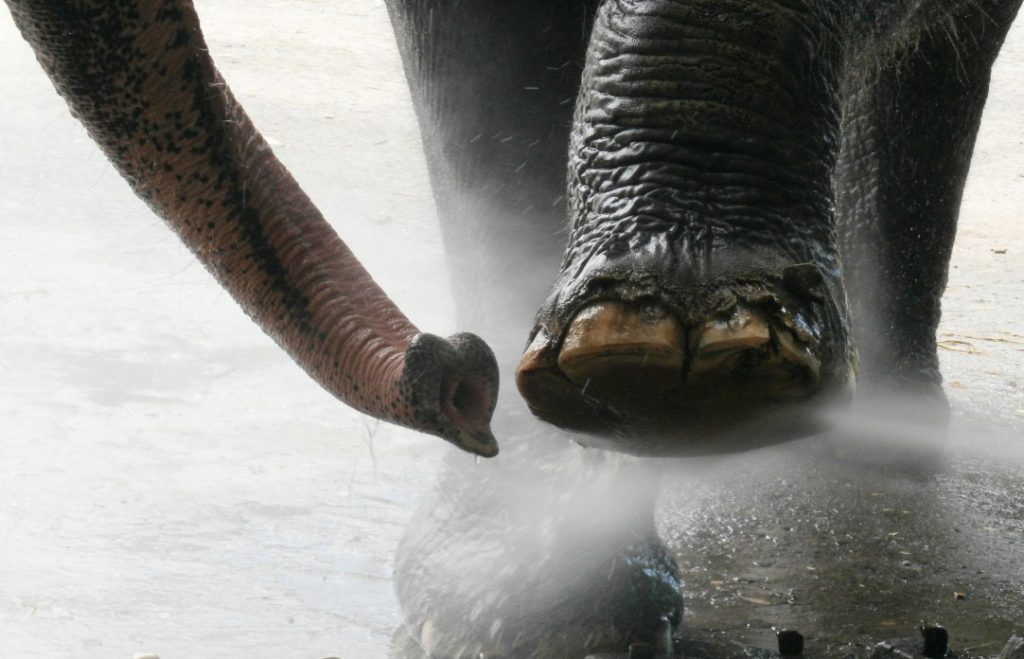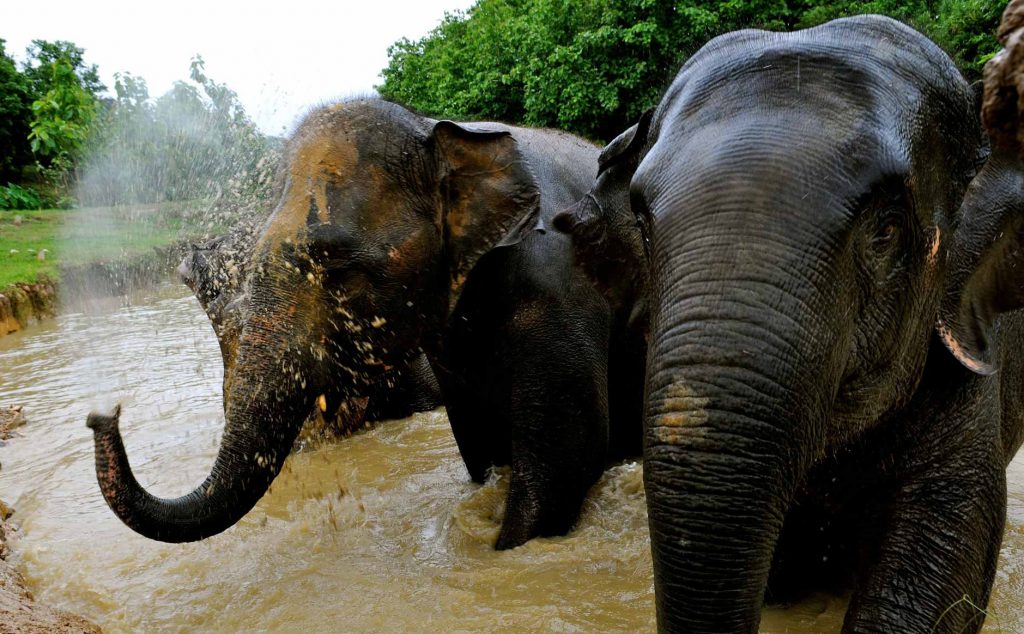Mali was more than an ordinary elephant. At the young age of three, she was removed from her family in Sri Lanka to be brought to a cemented zoo in the Philippines. She was a gift to then First Lady of the Philippines Imelda Marcos.
Mali remains to be more than an ordinary elephant. Still encaged behind the same cement walls, Mali has been the subject of a campaign more than a decade old. Her plight has brought to public attention the welfare of animals in zoos, while remaining to be captive herself.

We spoke with Ashley Fruno from People for the Ethical Treatment of Animals – Asia (PETA Asia) about Mali’s current condition, the Free Mali campaign, and the pro-zoo arguments. Manila Zoo was contacted for comment, but has not responded as of writing.
The plight of Mali
Mali’s home is cement: from the walls, to the floor, to the trees. Despite the tree paintings on cement walls, Mali’s cage is far from the environment she was robbed from.

Aching feet
“She is suffering from debilitating foot ailments, the leading cause of death in captive elephants,” Ashley shared on Mali’s condition.
Constantly walking on cement instead of the natural terrain her body is made for and having nowhere to go except her small cement enclosure, Mali currently suffers from joint and foot problems. “Veterinarians who have seen Mali and who have reviewed footage of her have said that she is in constant pain. Mali suffers from cracked nails and foot pads as well as overgrown cuticles. “

Lack of adequate veterinary care
All captive elephants at reputable zoos have blood work performed at least once a year and have regular foot care. But for almost 40 years, Mali has not had one single blood test, nor has she ever experienced foot care.
Solitude
“…Mali is unimaginably lonely. In the wild, female elephants stay in close-knit, extended groups for their entire lives. These complex social animals need other elephants in order to lead fulfilled, happy lives.”
Ashley continues, “Not a single zoological or elephant association allows for female elephants to be housed alone.”
Yet, Mali is housed alone. Ironically, the elephant who was presented as a gift as a symbol of friendship has never formed any bond or friendship with a fellow elephant. Mali had two companion elephants but they died shortly after her arrival. Mali has been alone in her cement enclosure since then — in solitude for 42 years.
A letter from a rock star to the Philippine president
Morrissey, known for being the frontman of the band The Smiths and for having a successful solo music career, reached out to the Philippine president on the case of Mali. He gave momentum to the campaign Free Mali.
Ashley talked to us about him: “In May 2012, musician Morrissey fired off a letter to then President Benigno Aquino III asking him to transfer Mali to a sanctuary. Shortly after, the Office of the President issued a directive stating that Mali should be considered for transfer.”
Mali’s home is cement: from the walls, to the floor, to the trees. Despite the tree paintings on cement walls, Mali’s cage is far from the environment she was robbed from.
Free Mali
A campaign spearheaded by PETA, Free Mali aims to remove Mali from her barren concrete cell to a reputable elephant shelter. At the shelter, she will receive the veterinary attention she requires, form bonds with fellow elephants, and live out her days just like how an elephant should.
A home for Mali
An elephant sanctuary in Thailand has been waiting for Mali to come home. Boon Lott’s Elephant Sanctuary (BLES) has 500 acres of banana plantations, fruit trees, grasslands, and freshwater rivers. Most importantly, once transported there, Mali will finally be able to interact and form bonds with her fellow elephants — an experience no amount of painted trees on cement walls can replace.

Arguments against “Free Mali”
Supporters of the Manila Zoo openly voiced out their concerns against freeing Mali from the zoo. Ashley addressed these concerns.
Argument: MALI’S BLOOD TESTS SHOW THAT SHE IS HEALTHY FOR HER AGE. DR. THONGTIP, AN ELEPHANT EXPERT FROM THAILAND, SAID MALI WAS IN THE “PINK OF HEALTH.”
Ashley: “Dr. Thongtip’s area of specialization is in theriogenology, and the only journals and academic studies that he has participated in focus on artificial insemination and reproduction of elephants. He is not qualified to assess Mali’s health, in particular her foot problems.
“…Dr. Thongtip also commented that a more thorough examination must be performed before her transfer is decided on, not that she shouldn’t go at all.”
Argument: MALI IS A SENIOR ELEPHANT. SHE WILL NOT SURVIVE THE TRAVEL AND LENGTHY QUARANTINE REQUIRED.
Ashley: “Around the world every year, elephants are successfully transported from zoo to zoo, from location to location by circuses, and from zoos to sanctuaries by truck, plane, and train. Transporting elephants is a common practice.
“…Many elephants who are transferred to sanctuaries have histories similar to Mali’s, but sanctuary caregivers find that these intelligent animals are highly adaptable and welcome new situations, especially those that greatly improve their welfare, as moving Mali would. To suggest that we should not give Mali a chance of being happy and healthy in the company of other elephants shows a lack of understanding of the nature of elephants and does a disservice to Mali. PETA has the backing of many international elephant and wildlife experts who are confident that Mali will cope very well in her new environment and that transferring her would be the kindest course of action — and the right thing to do for her welfare.”
Argument: MALI’S LAST YEARS WILL BE SPENT ADJUSTING TO A NEW ENVIRONMENT, AS OPPOSED TO HER LIVING THEM WHERE SHE HAS GROWN COMFORTABLE, WITH THE PEOPLE SHE HAS GROWN TO TRUST.
Ashley: “As Dr. Richardson said, ‘In my experience, even elephants who have been alone for more than 20 years integrate well with other elephants when moved to a sanctuary.’ Here is just one example: Tina, a 33-year-old elephant, spent much of her life alone at the Greater Vancouver Zoo in Canada after being sold to the zoo at the age of two. In 2003, after a three-and-a-half day journey to the Elephant Sanctuary in the U.S. state of Tennessee, Tina arrived at her forever home. Although Tina took some time to adjust to her new surroundings, as would all elephants, she made many friends at the sanctuary and was successfully integrated into their herd.
“Her best friend at the sanctuary was Tarra, and the two were almost inseparable. When Tina eventually died at the sanctuary as a result of a heart problem she arrived with (likely a birth defect), two of her other friends, Sissy and Winkie, spent the entire night with her body and stayed at her grave the entire following day. When they finally left, Sissy placed her favorite toy, a tire, on top of Tina’s grave. The staff at the sanctuary are experts in introducing unfamiliar elephants and find that female elephants bond to each other quickly.”
This appeared in Animal Scene magazine’s April 2019 issue.






